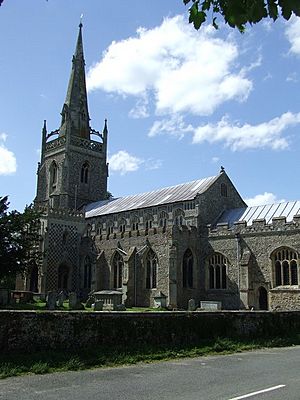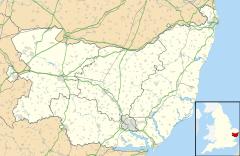Woolpit facts for kids
Quick facts for kids Woolpit |
|
|---|---|
 Church of St Mary |
|
| OS grid reference | TL973624 |
| District | |
| Shire county | |
| Region | |
| Country | England |
| Sovereign state | United Kingdom |
| Post town | Bury St Edmunds |
| Postcode district | IP30 |
| EU Parliament | East of England |
Woolpit is a charming village located in the English county of Suffolk. It sits right between the towns of Bury St. Edmunds and Stowmarket. In 2011, about 1,995 people lived in Woolpit. This village is famous for a mysterious story from the 12th century about the green children of Woolpit. It also has a beautiful old church with amazing wooden carvings from the Middle Ages. Woolpit is managed as a civil parish, which is part of the Mid Suffolk district.
Contents
Woolpit's Past: A Look at History
The name "Woolpit" comes from an old English phrase, wulf-pytt. This means "pit for trapping wolves," showing that wolves once lived in this area! The village's name was first written down in the 10th century as Wlpit.
Before the Norman Conquest of England, a person named Ulfcytel Snillingr owned the village. Later, between 1174 and 1180, Walter de Coutances became in charge of Woolpit. He was a close friend of King Henry II. After Walter left, Woolpit was given to the monks of Bury St Edmunds Abbey. Even Pope Alexander III agreed that the money from Woolpit should go to the abbey.
Old Village Fairs
In the 15th century, Woolpit held two big fairs every year.
- The Horse Fair happened on September 16th in two special fields.
- The Cow Fair took place on September 19th in its own field. At this fair, people sold cattle and even toys!
Important People and Charities
Sir Robert Gardiner, who was a very important judge in Ireland, owned the land in Woolpit from 1597 to 1620. He started a special house called an almshouse to help poor women from Woolpit and a nearby village called Elmswell. This charity, called the Gardiner charity, still helps people today. After Sir Robert died, Woolpit was passed to his grand-nephew, Gardiner Webb.
Woolpit Bricks
From the 17th century, the Woolpit area became a major place for making special "Suffolk White" bricks. These bricks were known for being very white and beautiful, almost like stone. In 1818, it was noted that many large houses in Suffolk were built using these bricks. Today, only the pits where the clay was dug remain.
Village Life and Mills
Woolpit is about 8 miles (13 km) southeast of Bury St. Edmunds. In 1831, 880 people lived here, and less than half of them worked in farming.
You can find Mill Lane in Woolpit, which is where an old windmill used to stand. It was taken down around 1924. Another mill was located on Windmill Avenue, but it fell down in 1963.
Today, Woolpit has a pub called The Bull, two tea rooms, and several shops. These include estate agents, a grocer's, hairdressers, a fish and chip shop, and Palmers Bakery. There's also a dentist and a shop called Woolpit Interiors. The village also has two industrial areas with larger businesses, a health clinic, and a school.
Village Population
In 1811, Woolpit had 625 people living in 108 houses. By 1821, the population had grown to 801 people living in 116 houses.
The Mysterious Green Children of Woolpit
One of the most famous stories from Woolpit is about the mysterious green children. Two writers from the Middle Ages, Ralph of Coggeshall and William of Newburgh, wrote about them. They said that sometime in the 12th century, two children suddenly appeared in Woolpit.
The boy and girl looked mostly normal, but their skin was green! They wore strange clothes and spoke a language no one understood. The only food they would eat was raw beans.
Over time, they learned to eat other foods, and their green skin faded away. Sadly, the boy became sick and died soon after they were baptized. The girl, however, got used to her new life. After learning to speak English, she explained that she and her brother came from a place called St Martin's Land. She said it was an underground world where all the people were green.
What Do People Think Happened?
Some people believe the story of the green children is a classic folk tale. It might be about meeting people from another world, perhaps one under our feet or even from outer space. Others think it's a mixed-up version of a real event. It could be linked to people from Flanders (a region in Belgium) who were living in the area at that time and were treated badly.
A local writer and folk singer named Bob Roberts wrote in his 1978 book A Slice of Suffolk that some people in Woolpit still claim to be related to the green children. However, he said no one would tell him who they were!
St Mary's Church
Saint Mary's Church, Woolpit is an important church in the village. It is part of the Deanery of Lavenham, which is in the Diocese of St Edmundsbury and Ipswich. The church is connected with the nearby village of Drinkstone and is called the "Benefice of Woolpit (Blessed Virgin Mary) with Drinkstone". In the past, the church had a statue of Saint Mary and a special well nearby.
Notable People from Woolpit
- Dr Helen Geake – She is an archaeologist and was a member of the TV show Time Team.
- Ian Lavender – He was an actor, famous for being a cast member in the TV show Dad's Army.
See also
 In Spanish: Woolpit para niños
In Spanish: Woolpit para niños



